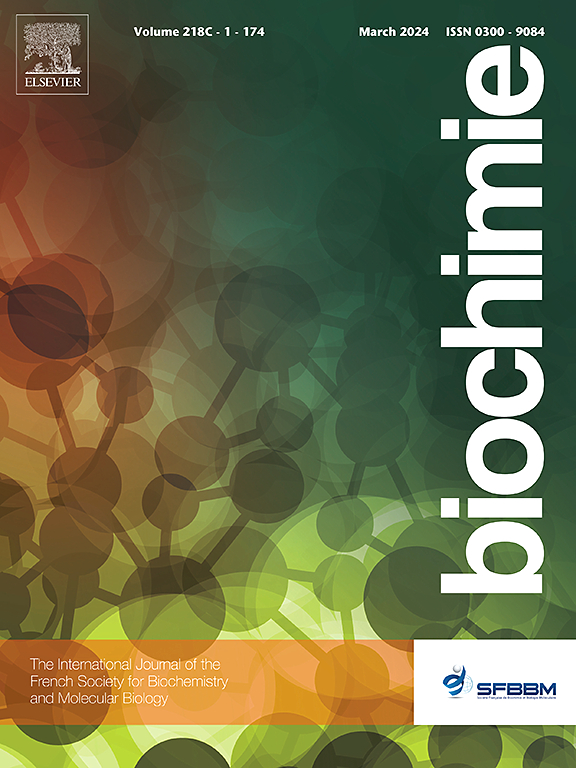Lunatin-1: a membrane-disruptive peptide isolated from Hadruroides lunatus scorpion venom with cytotoxicity against MDA-MB-231 breast cancer cell line
IF 3
3区 生物学
Q2 BIOCHEMISTRY & MOLECULAR BIOLOGY
引用次数: 0
Abstract
Membrane-disrupting peptides - including antimicrobial and antitumor peptides - disrupt cell membrane through pore formation. Strategies for using these peptides as adjuvants in cancer treatment regimens have been investigated. In the context of a high recurrence rate and ineffective postoperative adjuvant chemotherapy treatment in triple-negative breast cancer (TNBC), the potential antitumor cytotoxic effect of Lunatin-1 was evaluated for the first time in the TNBC cell line MDA-MB-231. Synthetic Lunatin-1 was purified and its purity confirmed by mass spectrometry. Cytotoxicity of this peptide against MDA-MB-231 cells was associated with a rapid increase in propidium iodide-positive cells and LDH release through the loss of membrane integrity in a concentration and time-dependent manner. Staining with CellMask Deep Red to outline the cell membrane showed its disruption 5 min after Lunatin-1 treatment, which was not associated with necroptosis. Ultrastructural analysis by scanning electron microscopy showed membrane damage due to microvilli reduction and increased density of pores per cell compared to untreated cells. We concluded that Lunatin-1 is a membrane-disruptive peptide in this cellular model, highlighting it as an interesting tool for conjugating with cancer markers or anticancer drugs.

月蝎蛋白-1:一种从月蝎毒液中分离的膜破坏肽,对乳腺癌细胞系MDA-MB-231具有细胞毒性。
膜破坏肽-包括抗菌肽和抗肿瘤肽-通过孔形成破坏细胞膜。已经研究了在癌症治疗方案中使用这些肽作为佐剂的策略。在三阴性乳腺癌(TNBC)复发率高、术后辅助化疗无效的背景下,首次在TNBC细胞系MDA-MB-231中评估了Lunatin-1的潜在抗肿瘤细胞毒作用。对合成的Lunatin-1进行了纯化,并用质谱法确定了其纯度。该肽对MDA-MB-231细胞的细胞毒性与碘化丙啶阳性细胞和LDH释放的快速增加有关,LDH释放通过膜完整性的丧失以浓度和时间依赖性的方式释放。用CellMask Deep Red染色勾勒出细胞膜在Lunatin-1治疗后5分钟出现破坏,与坏死坏死无关。扫描电镜超微结构分析显示,与未处理的细胞相比,微绒毛减少导致膜损伤,每个细胞的孔密度增加。我们得出结论,在这种细胞模型中,Lunatin-1是一种膜破坏肽,突出表明它是一种与癌症标志物或抗癌药物结合的有趣工具。
本文章由计算机程序翻译,如有差异,请以英文原文为准。
求助全文
约1分钟内获得全文
求助全文
来源期刊

Biochimie
生物-生化与分子生物学
CiteScore
7.20
自引率
2.60%
发文量
219
审稿时长
40 days
期刊介绍:
Biochimie publishes original research articles, short communications, review articles, graphical reviews, mini-reviews, and hypotheses in the broad areas of biology, including biochemistry, enzymology, molecular and cell biology, metabolic regulation, genetics, immunology, microbiology, structural biology, genomics, proteomics, and molecular mechanisms of disease. Biochimie publishes exclusively in English.
Articles are subject to peer review, and must satisfy the requirements of originality, high scientific integrity and general interest to a broad range of readers. Submissions that are judged to be of sound scientific and technical quality but do not fully satisfy the requirements for publication in Biochimie may benefit from a transfer service to a more suitable journal within the same subject area.
 求助内容:
求助内容: 应助结果提醒方式:
应助结果提醒方式:


